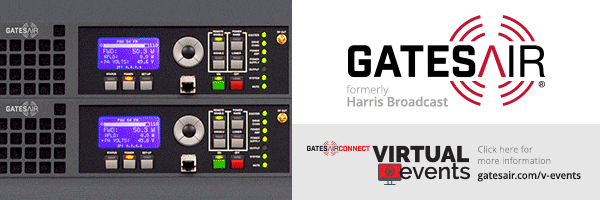In light of several canceled/postponed industry events around the world in 2020, GatesAir is presenting a special schedule of webinars and online events to keep you informed and engaged. This includes new product updates, topical presentations, round tables with special guests, and even “virtual booth meetings” to help personally support their broadcasting needs.
One of the recent webinars in this series was titled FM SFNs: A Toolkit to Extend Radio Coverage and featured Rich Redmond, President, GatesAir International.
While FM broadcasters around the world have long been able to license FM boosters or Single Frequency Networks (SFN) to augment the coverage of their main FM transmitting systems, implementation limitations often yielded poor results.
Redmond discussed how significant advances in FM transmitters have been able to augment coverages using real-time adaptive precision, time delay control and software coverage planning tools.
GeoBroadcast Solutions pioneered the concept of multiple boosters employing mobile-cellular type antenna patterns to create a focused coverage of the desired area with little signal overlapping the main coverage – MaxxCasting™. It features highly directional antennas with high front-to-back ratios, deployed in clusters focusing the RF energy specifically in the areas of desired coverage improvement. The relationship between antenna patterns, booster site selection, antenna elevation, booster ERP, directions of propagation and the related timing between the sites are just some of the variables that are analyzed and optimized to create seamless coverage.
GatesAir’s Intraplex SynchroCast® system employs patented technology that provides real time adaptive delay to maintain precision control in an SFN system.
 GatesAir Intraplex® IP Link with SynchroCast® technology provides the needed program transport and precision timing control enabling seamless coverage that today’s booster systems demand. The IP Link can transport analog and digital discrete L/R audio using a full range of compression and error mitigation options tailored to available network capacity. The MPX version transports both analog and digital AES192 composite MPX audio. This significant breakthrough of using MPX for SFN applications eliminates the use of multiple aligned stereo generators at transmitter sites and allows use of a single stereo generator in the main processor. This ensures the identical signal is delivered and time aligned for each transmitter site.
GatesAir Intraplex® IP Link with SynchroCast® technology provides the needed program transport and precision timing control enabling seamless coverage that today’s booster systems demand. The IP Link can transport analog and digital discrete L/R audio using a full range of compression and error mitigation options tailored to available network capacity. The MPX version transports both analog and digital AES192 composite MPX audio. This significant breakthrough of using MPX for SFN applications eliminates the use of multiple aligned stereo generators at transmitter sites and allows use of a single stereo generator in the main processor. This ensures the identical signal is delivered and time aligned for each transmitter site.
GatesAir Flexiva FAX line of solid-state, digitally modulated FM transmitters offer high power density and a very compact footprint. The FAX 3.5K can produce up to 3850 watts in a small 4 rack units of space and weighs a mere 56 lbs./25 kg. The combination of technology, integrated capabilities such as GPS, and the world-class digital exciter well supports SFN boosters in today’s space constrained environments.
One of the participants asked how does MPX simplify network design, does it need fewer aligned stereo generators while distributing a full MPX signal? Richmnod said that in a traditional design with left and right stereo send, discrete signals were distributed at all of the sites and either and outboard but aligned stereo generator or an on-board stereo generator were required. When you have one stereo generator, you take out all of that alignment requirement. The loudness control and such filtering is also done centrally in the audio processor.
To watch the full webinar, click here.
https://www.gatesair.com/webinars/fm-sfns-a-toolkit-to-extend-radio-coverage
Disclosure: Gates Air is an advertiser on AsiaRadioToday
Subscribe to daily flash briefing podcast on these platforms: Acast, Apple iTunes Podcasts, Podtail, Spotify, Google Podcasts, TuneIn, or wherever you get your podcasts.


